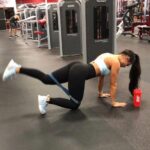Are you looking to get in shape and improve your overall health? One of the keys to success is having a consistent fitness routine at the gym. Whether you are new to working out or a seasoned veteran, having a structured plan is essential for achieving your fitness goals.
Creating your own gym workout plan can seem overwhelming, but it doesn’t have to be. In this article, we will discuss the importance of having a consistent fitness routine and provide tips on how to create an effective workout plan tailored to your needs. We will also explore key exercises for a full body workout, setting realistic fitness goals, incorporating cardio into your routine, the role of nutrition, avoiding common mistakes, and the importance of rest and recovery.
By following these guidelines and staying committed to your fitness routine at the gym, you will be well on your way to achieving your desired results. So let’s dive in and explore how you can take your fitness journey to the next level through a structured and consistent workout plan.
How to Create Your Own Gym Workout Plan
Creating a gym workout plan can be the key to achieving your fitness goals and maintaining a consistent fitness routine. Whether you are new to working out or looking to switch up your current routine, having a plan in place can help you stay motivated and focused. Here are some tips on how to create your own gym workout plan:
Assess Your Fitness Goals
Before creating a gym workout plan, it’s important to assess your fitness goals. Whether you want to build muscle, lose weight, improve endurance, or simply stay active, identifying your goals will help you tailor your workout plan to meet your specific needs.
Choose Your Exercises Wisely
When creating a gym workout plan, it’s important to include exercises that target different muscle groups for a full body workout. Incorporating compound exercises like squats, deadlifts, bench press, and pull-ups can help you maximize your time at the gym and achieve balanced muscle development.
Create a Structured Plan
Once you’ve identified your fitness goals and chosen the exercises you want to incorporate into your routine, it’s time to create a structured plan. This includes determining how many days per week you’ll work out, which exercises you’ll do on each day, and how many sets and reps of each exercise you’ll perform.
By following these steps and taking the time to create a well-rounded gym workout plan that aligns with your fitness goals, you can set yourself up for success in sticking to a consistent fitness routine at the gym. Remember that staying flexible with your plan as needed is also important for long-term adherence and enjoyment of exercise.
Top 5 Key Exercises for a Full Body Workout Routine
A full body workout routine is essential for achieving overall strength, muscle development, and fitness. Incorporating a variety of exercises that target different muscle groups can help you to achieve a balanced and effective workout. Here are the top 5 key exercises that should be included in your full body workout routine at the gym:
- Squats: Squats are an excellent compound exercise that targets the lower body, including the quadriceps, hamstrings, glutes, and calves. They also engage the core for stability and balance.
- Deadlifts: Deadlifts work multiple muscle groups including the back, glutes, hamstrings, and core. They are a great functional exercise that mimics everyday movements like lifting objects off the ground.
- Bench Press: The bench press is a classic upper body exercise that primarily targets the chest, shoulders, and triceps. It is an effective way to build upper body strength and muscle mass.
- Pull-Ups/Chin-Ups: Pull-ups and chin-ups are challenging upper body exercises that work the back, biceps, and forearms. They also engage the core for stability.
- Overhead Press: The overhead press is a fundamental shoulder exercise that targets the deltoid muscles. It helps to develop strength and stability in the shoulders, which is important for overall upper body strength.
Including these key exercises in your full body workout routine at the gym will ensure that you are targeting all major muscle groups for balanced strength and development.
In addition to these key exercises, it is important to incorporate variations and adjustments based on individual fitness levels, goals, and preferences. Consulting with a personal trainer or fitness professional at your gym can help you customize your workout plan to meet your specific needs and ensure proper form during each exercise.
Remember to start with lighter weights when trying new exercises or if you’re unsure of your capabilities. Gradually increase intensity as you build strength and confidence with each movement.
With consistency and dedication to your full body workout routine at the gym, you will see improvements in overall strength, endurance, and physical fitness over time.
Setting Realistic Fitness Goals for Your Gym Routine
Understanding the Importance of Realistic Fitness Goals
When it comes to setting fitness goals for your gym routine, it’s crucial to be realistic. Setting unrealistic goals can lead to frustration and disappointment, while realistic goals can help you stay motivated and on track. Realistic fitness goals are those that are achievable within a reasonable time frame and align with your current fitness level. Whether your goal is to lose a certain amount of weight, increase muscle mass, or improve overall endurance, setting realistic expectations is key.
Creating Specific and Measurable Goals
When setting fitness goals for your gym routine, it’s important to make them specific and measurable. Instead of saying “I want to get in shape,” try setting a specific goal such as “I want to be able to run a 5k in under 30 minutes” or “I want to increase my bench press by 20 pounds.” By making your goals measurable, you can track your progress and celebrate each milestone along the way.
Adjusting Your Goals According to Progress
It’s important to remember that fitness goals are not set in stone. As you progress through your gym routine, you may find that some goals become easier to achieve while others may need to be adjusted. Be flexible with your fitness goals and allow yourself to modify them as needed. This will help you stay focused and continue making progress in your fitness journey.
By setting realistic fitness goals for your gym routine, you can create a clear roadmap for success and stay motivated as you work towards achieving your desired results. Whether it’s increasing strength, improving cardiovascular endurance, or reaching a specific body composition goal, having clear and achievable targets will help keep you on track in your fitness journey at the gym.
The Benefits of Adding Cardio to Your Gym Routine
Cardiovascular exercise, also known as cardio, is a key component of any effective fitness routine at the gym. Including cardio in your workout plan offers countless benefits to your overall health and well-being. Here are some of the advantages of adding cardio to your gym routine:
- Improved Heart Health: Cardio exercises such as running, cycling, or using the elliptical machine can strengthen your heart and improve its efficiency. Over time, this can reduce the risk of heart disease and other cardiovascular conditions.
- Weight Management: Incorporating regular cardio workouts into your fitness routine can help you burn calories and manage your weight more effectively. Whether your goal is to lose weight or maintain a healthy body composition, cardio can be a valuable tool in achieving this.
- Enhanced Endurance: Engaging in cardiovascular exercise can improve your endurance levels, allowing you to perform better during other aspects of your gym workout plan. With increased stamina, you’ll be able to push yourself further and accomplish more during your fitness routine.
- Stress Relief: Many people find that participating in cardio activities like jogging or swimming helps to alleviate stress and improve their mood. The endorphins released during these workouts can have a positive impact on mental well-being.
By including various forms of cardio in your gym routine, you can experience these benefits firsthand and improve your overall fitness level.
In addition to the physical advantages, incorporating cardio into your fitness routine at the gym provides an opportunity for variety and diversity in your workouts. This can help prevent boredom and plateaus in progress by challenging different muscle groups and energy systems.
The Role of Nutrition in Supporting Your Fitness Routine at the Gym
When it comes to fitness, one of the most crucial aspects is the role of nutrition in supporting your gym routine. What you eat plays a significant role in achieving your fitness goals, whether it’s building muscle, increasing endurance, or losing weight. Your body’s ability to perform during your workouts and recover afterward is heavily influenced by the food you consume.
Proper nutrition is essential for fueling your body before a workout and for recovery after a workout. Before hitting the gym, a balanced meal with carbohydrates, protein, and healthy fats can provide the energy needed to power through your exercise routine. After a workout, it’s important to replenish nutrients and aid in muscle recovery by consuming post-workout snacks or meals that are rich in protein and include some complex carbohydrates.
In addition to fueling your workouts and promoting recovery, nutrition also plays a crucial role in overall health. A well-balanced diet can improve your immune system, enhance mental focus during workouts, and reduce the risk of chronic diseases. Therefore, paying attention to what you eat not only benefits your fitness routine at the gym but also contributes to your overall well-being.
| Nutrition | Effect |
|---|---|
| A balanced meal with carbohydrates, protein, and healthy fats before a workout | Provides energy for exercise routine |
| Consuming post-workout snacks or meals rich in protein and complex carbohydrates | Promotes muscle recovery |
| A well-balanced diet | Improves immune system and overall health |
Avoiding Common Mistakes in Your Gym Fitness Routine
When it comes to your fitness routine at the gym, it’s important to be mindful of common mistakes that can hinder progress and potentially lead to injury. One of the most common mistakes is not properly warming up before starting your workout.
Warming up helps prepare your body for the physical activity ahead, and skipping this crucial step can increase your risk of strains and sprains. Incorporating dynamic stretches and light cardio into your warm-up routine can help get your muscles ready for exercise.
Another mistake to avoid is using improper form during exercises. It’s essential to prioritize proper form over lifting heavy weights or doing more reps. Incorrect form not only decreases the effectiveness of the exercise but also increases the risk of injury. If you’re unsure about the proper form for a particular exercise, don’t hesitate to ask a fitness trainer at the gym for guidance.
Additionally, neglecting rest and recovery can also be a common mistake in a gym fitness routine. While it’s important to stay committed to your workouts, overtraining can lead to burnout and potential injuries. Make sure to incorporate rest days into your workout plan and listen to your body’s signals for fatigue or muscle soreness. Rest and recovery are essential for muscle repair and growth, so don’t overlook their importance in your overall fitness routine at the gym.
By being mindful of these common mistakes and taking proactive steps to address them in your gym fitness routine, you can work towards reaching your fitness goals safely and effectively. Pay attention to proper warm-ups, exercise form, and rest and recovery strategies as part of your overall approach to fitness at the gym.
Incorporating Rest and Recovery Into Your Gym Routine
After a challenging workout at the gym, it may be tempting to push yourself to go harder and longer each time. However, incorporating rest and recovery into your fitness routine is crucial for achieving optimal results and preventing injuries. Rest days allow your body to repair and rebuild itself, which is essential for muscle growth and overall physical well-being. Ignoring the importance of rest can lead to overtraining, burnout, and a plateau in your fitness progress.
When planning your gym workout routine, it’s important to schedule adequate rest days. This means taking a day off from intense exercise or engaging in low-impact activities such as yoga or walking. Additionally, getting enough sleep is an integral part of the recovery process. Aim for 7-9 hours of quality sleep each night to support muscle repair and cognitive function.
Incorporating rest and recovery techniques such as foam rolling, stretching, and massage can also help alleviate muscle soreness and improve flexibility. These methods can be incorporated into post-workout cool-downs or on rest days to ensure that your body remains in peak condition for your next gym session.
| Rest and Recovery Techniques | Benefit |
|---|---|
| Foam Rolling | Alleviates muscle soreness |
| Stretching | Improves flexibility |
| Massage | Aids in muscle relaxation |
The Importance of Tracking Your Progress in Your Fitness Routine at the Gym
In conclusion, maintaining a consistent fitness routine at the gym is essential for achieving your health and wellness goals. By establishing a regular schedule and sticking to it, you can see significant improvements in strength, endurance, and overall well-being. Additionally, creating a personalized workout plan that incorporates a variety of exercises, including strength training, cardio, and flexibility exercises can help you achieve a full body workout routine that targets different muscle groups.
Setting realistic fitness goals is crucial for staying motivated and seeing progress in your gym routine. By tracking your progress over time, you can celebrate your accomplishments and make adjustments as needed to continue challenging yourself. It’s also important to remember the role of rest and recovery in supporting your fitness routine – giving your body time to heal and repair itself is just as important as the actual workouts.
Incorporating proper nutrition into your fitness routine can further enhance your results at the gym. Eating a balanced diet that includes nutrients to support muscle growth and energy levels is key for achieving optimal performance during workouts.
Lastly, avoiding common mistakes and paying attention to form during exercises can help prevent injury and ensure that you are getting the most out of your gym sessions. With these tips in mind, tracking your progress in your fitness routine at the gym will help you stay on track towards achieving your health and wellness goals.
Frequently Asked Questions
What Is a Good Gym Workout Routine?
A good gym workout routine includes a mix of cardio, strength training, and flexibility exercises. It’s important to incorporate different types of exercises to work different muscle groups and prevent boredom or plateaus in progress.
What Is a Good Schedule for Going to the Gym?
A good schedule for going to the gym depends on individual preferences and availability. Some people prefer working out in the morning to start their day with energy, while others find it more manageable to hit the gym after work or before bed.
Ultimately, consistency is key, so choosing a time that works best for you and sticking to it is important.
What Are the Big 3 Gym Routine?
The Big 3 gym routine refers to three fundamental strength training exercises: squats, deadlifts, and bench presses. These exercises target multiple muscle groups and are considered foundational movements in many weightlifting programs. Integrating the big 3 into a workout routine can help build overall strength and muscle mass.

Passionate about providing useful information to anyone with an interest in the field of Personal Training, I strive to pass on to our readers quality information and to answer any questions about Personal Trainers, the work they do and how to become one.





